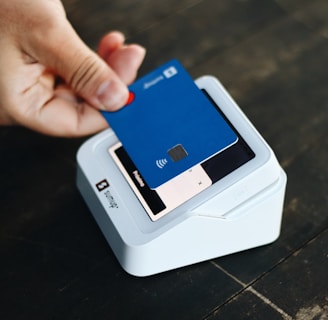
4 Ways Paying for EV Charging Could Be Less Annoying
Paying for EV Charging is getting better every day
INDUSTRY


How do you pay for an EV Charging station?
There are four main ways to pay for an EV charging station - using the app, credit card tap, RFID card and the newly introduced Plug and Charge method. Each process has it’s own pros and cons depending which side of the business you’re on. Read below for more information and learn about the exciting new technology in the developing industry of EV charging.
Introduction
One of my least favourite things to do is park downtown in an unfamiliar place. Why? Because there is a chance the parking lot may be managed by an unknown company, requiring me to download a new app, input my credit card details, and process the payment. All of this when I’m in a rush or excited to get where I’m going.
This is one of the struggles that EV drivers are familiar with although it’s not paying for parking, it’s paying for charging. Luckily the EV charging market is still developing and improving daily. Efforts are underway to streamline payment for EV charging and enhance the driver's experience. Currently, there are four major payment methods. The advantages and disadvantages of each will be discussed below.
1. Payment Through the App
This is the most common way payments are currently processed for EV Charging sessions. Nearly every EV charging company has their own dedicated app. To use their charging stations, you must download the app, input your credit card details, and provide your contact information. EV Box goes into more detail on EV charging apps in their article here.
PROS
Your payment information is saved, allowing you to enter your credit card information just once.
You can track your spending, energy consumption and monitor charging history.
Increasingly, more apps are becoming compatible with a variety of chargers.
You can easily locate nearby EV chargers.
For the host, customers are likely to return once they've registered for the app due to its convenience.
CONS:
The biggest disadvantage is having to download different apps every time you want to use a new EV Charger. This is very annoying similar to when you’re trying to pay for parking at a new parking lot.
Entering payment information into an app can be tedious.
Some parking areas have poor cellular connections, making downloads challenging.
For the host, the requirement for your customers to download an app might discourage them from using their chargers.
2. Tap to Charge
A less common but convenient method of paying for EV Chargers is through credit card tap. This option is only available if the EV Charging company decides to install card tap devices on their chargers.
I’m a big fan of this method because it eliminates the need to download multiple apps for payment processing. This will create a better experience for users and attract new customers.
PROS
This method offers the quickest and easiest way to pay for EV chargers.
Due to its ease of use, it is more likely to attract new customers.
Its simplicity might encourage more people to adopt electric vehicles.
This method is great if you'll only be using the charger once or twice, such as when you're passing through the area.
I support this method due to ease of use and security. Most people don’t like uploading their personal and banking information online so tap to charge offers a good solution.
CONS
You can't monitor your charging session or track spending like with an app.
Most EV Chargers aren’t equipped with tap terminals.
The tap terminal is an external device which will have a higher likelihood of technical issues.
Using the terminal may add processing fees.
Returning customers may find it easier to just upload their credit card information to an app.
As a host, you won't receive the users contact information or related data which is valuable.
3. RFID Cards
RFID Cards are an interesting way of initiating an EV Charging station but they have their time and place. They are commonly used in locations such as hotels, where the host wants to restrict free charging to certain users. For instance, a hotel may offer free charging as a service to its guests, but they wouldn't want the chargers to be universally free. To authenticate users, the hotel typically provides guests with special RFID cards. The guests simply tap these cards on the machine to begin their complimentary charging session. BC Hydro also uses RFID cards.
PROS
Highly effective in unique situations such as hotels or valet parking.
Simple and easy to use. Provides a quick and accurate method of authentication.
Tracks who uses a charger and for how long.
Most EV Chargers come equipped with RFID card readers.
CONS
Not suitable for all charging situations, like public charging.
Must provide the user with the card manually and hope for its return.
There can sometimes be issues with the RFID magnet working properly.
You must keep track of the card to avoid losing it.
4. Plug & Charge - Newly Introduced
The "Plug and Charge" payment method is an exciting new development still being rolled out. The main intention of the "Plug and Charge" method is to simplify the payment process. You simply plug the charger into your car, and it processes the payment and starts charging automatically. Your EV stores your credit card and identification data, and authenticates you automatically. There's no need for apps or credit cards, making it even easier than refueling at a gas station. EV Box goes into more detail about the introduction of plug and charge payment systems here.
PROS
Plug-and-charge provides improvements in data security during the charging process.
It offers a more seamless experience for EV users.
It's faster, eliminating the need to upload information or use your wallet.
CONS
It's new technology and not yet perfected.
Since it's integrated into the physical car, it will take time to become standard across the industry.
Not yet widely adopted for all chargers and electric vehicles.
Conclusion
The journey to find the easiest payment solution for EV charging continues. Whether you prefer the convenience of an app, the quick tap of a credit card, the unique access provided by RFID cards, or the future potential of plug-and-charge, each method offers its own advantages and challenges. Either way it’s good to see the industry making advances and placing a high priority on making charging better for everyone to use.
As we move forward, I’m excited to watch these advancements unfold and will continue keeping you in the loop as I learn more. As always, I’m here if you need anything so please don’t hesitate to reach out.
Chao,
Strong Energy












